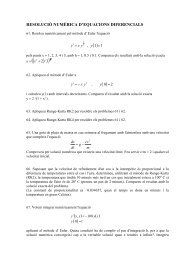Universitat de - Departament d'Astronomia i Meteorologia ...
Universitat de - Departament d'Astronomia i Meteorologia ...
Universitat de - Departament d'Astronomia i Meteorologia ...
Create successful ePaper yourself
Turn your PDF publications into a flip-book with our unique Google optimized e-Paper software.
82 Chapter 2. Multiwavelength approach to LS 5039<br />
object and flows with a velocity v = β c. The lateral expansion of the jet is parame-<br />
terized as r = r0(z/z0) ɛ , where r0 is the initial jet radius. A freely expanding conical<br />
jet would correspond to ɛ = 1, while for slowed lateral expansion we would have<br />
ɛ < 1 (see e.g. Hjellming & Johnston, 1988). The expansion velocity perpendicular<br />
to the jet axis is thus v⊥ = dr/dt = ɛvr/z. Concerning the magnetic field, we will<br />
only consi<strong>de</strong>r the component perpendicular to the jet axis, because it has the slowest<br />
<strong>de</strong>cay if conservation of the magnetic flux is assumed. The magnetic field along the<br />
jet will be thus parameterized as B = B0(r/r0) −1 = B0(z/z0) −ɛ .<br />
A relativistic electron injected at the base of the jet will <strong>de</strong>crease its energy<br />
mainly through adiabatic expansion, IC and synchrotron losses according to:<br />
dE<br />
dt<br />
v⊥E<br />
= −2<br />
3 r − αICUradE 2 − αSB 2 E 2 . (2.8)<br />
The factor 2/3 in the adiabatic expansion term comes from the lateral expansion of<br />
the jet. The constants αIC = 3.97 × 10 −2 and αS = 2.37 × 10 −3 (c.g.s. units) are the<br />
coefficients of the terms accounting for IC and synchrotron losses, respectively. The<br />
radiation energy <strong>de</strong>nsity Urad is assumed to be dominated by stellar UV photons from<br />
the O6.5V star, whose luminosity above 10 eV amounts to L∗ 5 × 10 38 erg s −1<br />
and Urad = L∗/[4πc(a 2 + z 2 )]. With the recently <strong>de</strong>termined orbital parameters<br />
(McSwain et al. 2001, McSwain & Gies 2002), the likely semimajor axis of the<br />
orbit is a = 2.6 × 10 12 cm. Adopting these parameters, the radiation energy <strong>de</strong>nsity<br />
close to the compact object is so high that electrons with energies of 10 −3 –10 −2 erg<br />
(γe ∼ 10 3 –10 4 ) will naturally produce γ-ray photons with energies of 100–1000 MeV,<br />
as <strong>de</strong>tected by EGRET. Moreover, integration of Eq. 2.8 taking only into account<br />
the IC losses gives:<br />
E(t) =<br />
E0<br />
1 + αICL∗E0<br />
4πcav tan−1<br />
, (2.9)<br />
vt<br />
a<br />
which reveals that the energy of the electrons <strong>de</strong>cays very fast to values of ∼ 5 ×<br />
10 −4 erg, regardless of their initial energy (the expression above is asymptotic).<br />
If we consi<strong>de</strong>r the IC contribution in Eq. 2.8 to be comparable to adiabatic losses<br />
at the base of the jet (later on, the adiabatic expansion term will soon become<br />
dominant due to its slower <strong>de</strong>cay as z −1 ), at the base of the jet we can request the<br />
following:<br />
αIC<br />
L∗<br />
4πc(a 2 + z 2 0) E2 0<br />
2ɛ vE0<br />
<br />
3 z0<br />
. (2.10)






